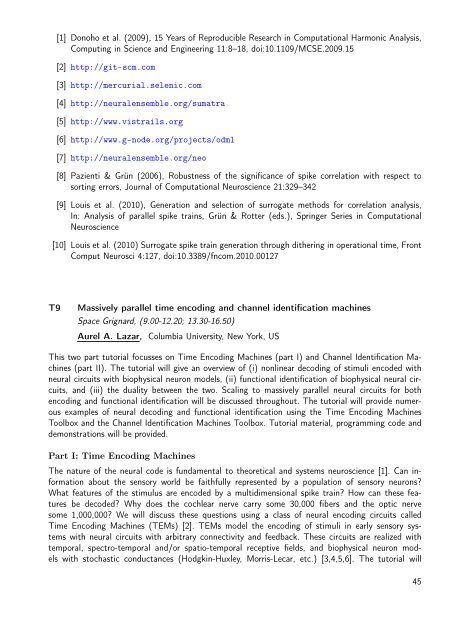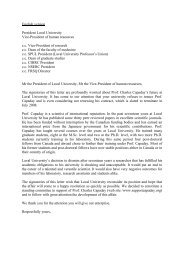Untitled - Laboratory of Neurophysics and Physiology
Untitled - Laboratory of Neurophysics and Physiology
Untitled - Laboratory of Neurophysics and Physiology
Create successful ePaper yourself
Turn your PDF publications into a flip-book with our unique Google optimized e-Paper software.
[1] Donoho et al. (2009), 15 Years <strong>of</strong> Reproducible Research in Computational Harmonic Analysis,<br />
Computing in Science <strong>and</strong> Engineering 11:8–18, doi:10.1109/MCSE.2009.15<br />
[2] http://git-scm.com<br />
[3] http://mercurial.selenic.com<br />
[4] http://neuralensemble.org/sumatra<br />
[5] http://www.vistrails.org<br />
[6] http://www.g-node.org/projects/odml<br />
[7] http://neuralensemble.org/neo<br />
[8] Pazienti & Grün (2006), Robustness <strong>of</strong> the significance <strong>of</strong> spike correlation with respect to<br />
sorting errors, Journal <strong>of</strong> Computational Neuroscience 21:329–342<br />
[9] Louis et al. (2010), Generation <strong>and</strong> selection <strong>of</strong> surrogate methods for correlation analysis,<br />
In: Analysis <strong>of</strong> parallel spike trains, Grün & Rotter (eds.), Springer Series in Computational<br />
Neuroscience<br />
[10] Louis et al. (2010) Surrogate spike train generation through dithering in operational time, Front<br />
Comput Neurosci 4:127, doi:10.3389/fncom.2010.00127<br />
T9<br />
Massively parallel time encoding <strong>and</strong> channel identification machines<br />
Space Grignard, (9.00-12.20; 13.30-16.50)<br />
Aurel A. Lazar, Columbia University, New York, US<br />
This two part tutorial focusses on Time Encoding Machines (part I) <strong>and</strong> Channel Identification Machines<br />
(part II). The tutorial will give an overview <strong>of</strong> (i) nonlinear decoding <strong>of</strong> stimuli encoded with<br />
neural circuits with biophysical neuron models, (ii) functional identification <strong>of</strong> biophysical neural circuits,<br />
<strong>and</strong> (iii) the duality between the two. Scaling to massively parallel neural circuits for both<br />
encoding <strong>and</strong> functional identification will be discussed throughout. The tutorial will provide numerous<br />
examples <strong>of</strong> neural decoding <strong>and</strong> functional identification using the Time Encoding Machines<br />
Toolbox <strong>and</strong> the Channel Identification Machines Toolbox. Tutorial material, programming code <strong>and</strong><br />
demonstrations will be provided.<br />
Part I: Time Encoding Machines<br />
The nature <strong>of</strong> the neural code is fundamental to theoretical <strong>and</strong> systems neuroscience [1]. Can information<br />
about the sensory world be faithfully represented by a population <strong>of</strong> sensory neurons<br />
What features <strong>of</strong> the stimulus are encoded by a multidimensional spike train How can these features<br />
be decoded Why does the cochlear nerve carry some 30,000 fibers <strong>and</strong> the optic nerve<br />
some 1,000,000 We will discuss these questions using a class <strong>of</strong> neural encoding circuits called<br />
Time Encoding Machines (TEMs) [2]. TEMs model the encoding <strong>of</strong> stimuli in early sensory systems<br />
with neural circuits with arbitrary connectivity <strong>and</strong> feedback. These circuits are realized with<br />
temporal, spectro-temporal <strong>and</strong>/or spatio-temporal receptive fields, <strong>and</strong> biophysical neuron models<br />
with stochastic conductances (Hodgkin-Huxley, Morris-Lecar, etc.) [3,4,5,6]. The tutorial will<br />
45



